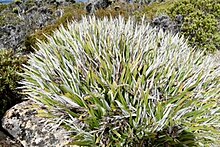Astelia alpina
| Astelia alpina | |
|---|---|
 |
|
| Astelia alpina at the summit of Mount Wellington | |
| Scientific classification | |
| Kingdom: | Plantae |
| Clade: | Angiosperms |
| Clade: | Monocots |
| Order: | Asparagales |
| Family: | Asteliaceae |
| Genus: | Astelia |
| Species: | A. alpina |
| Binomial name | |
|
Astelia alpina R.Br. |
|
Astelia alpina called pineapple grass, silver astelia, or perching lily is a commonly found species in alpine and subalpine areas of Tasmania and the Australian Alps. It is a perennial herb that typically dominates its environment by growing in dense clusters, called mats, in alpine bogs. There are two subspecies: Astelia alpina var. novae hollandiae from New South Wales and Victoria and Astelia alpina var. alpina endemic to Tasmania. Both subspecies appear very similar to each other. The species was originally described by Robert Brown.
Pineapple grass has green leaves with silvery, hairy undersides, appearing similar to the vegetative leaves of a pineapple plant. The leaves up to 30 cm long, 2–3 cm wide, tapering to a point at the end. Leaves are stiff and have recurved margins. The lower surface is covered with many fine white hairs, called trichomes, while the upper surface is green with the occasional hair. When viewed under the microscope, each trichome has a base of two glandular cells that stains dark. Flowers are small and white-green. When present at the base of the leaves, fruits are red ovals about 12mm long, fleshy, and edible. The male panicle has 10-60 flowers, while the female panicle has a maximum of 30 flowers.
Flowers appear on pineapple grass in summer on structures called racemes. The plant is dioecious, meaning it has separate male and female flowers. Like other species of Astelia, which grow in areas that are moist and humid, the ovary is full of mucilage, which is thought to function in pollen transmittance. Humans can facilitate asexual reproduction by breaking apart mature clumps and planting them separately. Males produce more flowers and inflorescences than females.
Pineapple grass is commonly found in the subalpine and alpine areas of Tasmania and the Australian Alps. In these habitats, plants must be tough to survive the harsh wind exposure, hot sun in summer, and freezing in winter. The Tasmanian species typically dominates alpine sedgeland and is found on all mountains in Tasmania. It prefers moist soils, and often occurs together with the coral fern (Gleichenia alpina), and other alpine plants including Empodisma minus, Carpha alpina, and Restio australis.
...
Wikipedia
